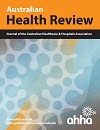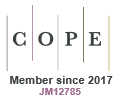
Australian Health Review
Volume 49 Number 5 2025
AH25207Driving excellence in aged care and healthy ageing
What is known about the topic? Why is there so much attention paid to persons receiving aged and home care at the expense of those in the unpaid economy? Why do some calls for a new initiative for older Australians fall on deaf ears. What does this paper add? This paper gives an insight into why the emphasis is on older persons receiving care funded by the Commonwealth and not on initiatives that could improve the lives of older persons in general. What are the implications for practitioners? Practitioners’ can be aware of the difference between preventive social initiatives and those firmly rooted in the medical model of health care.
What is known about the topic? This article explores the integration of artificial intelligence (AI) in aged care, emphasising that technology cannot substitute for systemic reform. While AI is already deployed to detect pain, predict falls, and reduce administrative burdens, its risks include bias, depersonalisation, and inequity when adopted without ethical guardrails. What does this paper add? The article proposes three guiding questions: who designs the AI and who is missing, what outcomes it optimises for, and whether it reduces or reinforces inequities. What are the implications for practitioners? The article concludes that AI should augment—not replace—care, ensuring dignity, equity, and human rights remain at the centre of aged care systems.
AH25202Reflections of a former Chief Economist on the past 25years of Australian Government aged care policy
What is known about the topic? The new Aged Care Act that will commence on 1 November 2025 will significantly reform/disrupt the provision of aged care services in Australia. What does this paper add and What are the implications for practitioners? This paper suggests that the new Act will not achieve the outcomes desired by the Royal Commission into Aged Care Quality and Safety as it does not establish the two key building blocks to aged care reform that were identified by the Commission: independence from Government and a secure source of funding. It argues that a philosophical shift is required that places the people receiving care at the centre of quality and safety regulation through the establishment of an independent Aged Care Commission with guaranteed funding though a hypothecated Aged Care Levy.
What is known about the topic? There has been increasing evidence demonstrating the adverse impact of hospital-acquired complications (HACs) on patient outcomes and associated financial loss. HACs are significantly preventable. What does this paper add? This study bridges a knowledge gap in the literature, particularly in the Australian context, describing the practical implementation, outcomes, and evaluation of a wholistic program specifically designed to systematically reduce preventable HACs at the hospital level. What are the implications for practitioners? Financially viable opportunities are available to hospitals to mitigate clinical risks, reduce preventable patient harm, and minimise unnecessary operational costs.
What is known about the topic? Health libraries support evidence-based health care, but are often under-resourced. What does this paper add? This study benchmarks staffing and reporting structures in Australian health libraries, revealing a 34% workforce shortfall and highlighting the strategic value of clinical-aligned reporting. What are the implications for practitioners? Adopting a 1:1250 staffing ratio and aligning reporting lines with clinical or research portfolios can strengthen advocacy, visibility and service impact.
What is known about the topic? Access to specialist care in regional and remote areas often necessitates extensive travel, imposing personal, systemic, and environmental burdens. What does this paper add? This study quantifies travel to public neurosurgery outpatient clinics in South Australia, estimating 1.75 million km travelled, 185,531 L of fuel consumed, 435.6 tonnes of CO2 emitted, and over AUD 357,000 in fuel costs across 19,148 appointments. What are the implications for practitioners? These findings underscore the environmental and economic impact of in-person care and support expanded adoption of telehealth and outreach models to promote sustainable, equitable service delivery.
What is known about the topic? Despite a doubling of the number of medical graduates almost 25 years ago, health workforce shortages and persistent problems with their distribution remain. What does this paper add? Progress with health workforce reforms has been slow and patients should not have to experience the harms of health workforce shortages and surpluses for another next 25 years. What are the implications for practitioners? A more local approach to health workforce planning is needed to help understand and address shortages.
What is known about the topic? Demographic trends, healthcare expenditure and workforce shortages are all contributors to pressure on the health system. What does this paper add? This paper contextualises the above three major factors affecting the health system to demonstrate the need to prepare for, and avert, a healthcare crisis. What are the implications for practitioners? Developing and implementing efficient and cost-effective technologies with transformative change are paramount to ensure a high-quality healthcare system is maintained.
AH25172 Abstract | AH25172 Full Text | AH25172PDF (913 KB) Open Access Article
What is known about the topic? Allied health professionals play a crucial role in supporting people with young-onset dementia through the National Disability Insurance Scheme, but access and coordination of services remain inconsistent, and often poorly aligned with its progressive nature and changing needs. What does this paper add? This paper identifies key issues faced by people with young-onset dementia in accessing allied health services through the National Disability Insurance Scheme, and proposes targeted areas for systemic reform. What are the implications for practitioners? System-level improvements to the National Disability Insurance Scheme are needed to collaborate effectively and deliver tailored allied health services for people with young-onset dementia.
What is known about the topic? Development opportunities for allied health professionals have the potential to improve not only skill attainment, job satisfaction and workforce retention, they also facilitate safer patient care and better outcomes. What does this paper add? This paper describes a development program targeted to early career allied health professionals working across a large health district, and investigates broader goal attainment and participant engagement. What are the implications for practitioners? A development program designed specifically for early career allied health professionals can be effective; however, such programs require support to both participants and their managers to embed them.
AH24318Relation between emergency department patient volume at time of patient arrival and likelihood of patient to ‘wait’ for clinical care. A state-wide data linkage analysis from New South Wales, Australia
What is known about the topic? The did not wait (DNW) group of patients are typically younger, present during evening or night hours, and cite long wait times as the primary reason for leaving. On review of these studies, they are all single centre studies. What does this paper add? Our study analysed state-wide linked data and showed that rising ED patient volumes significantly increased the likelihood of not waiting. Those in the highest patient volume quintile were 3.5 times more likely not to wait, with younger age (15–24 year group) being 6.1 times and lower triage category 5 being 13.3 times more likely not to wait. What are the implications for practitioners? Targeted interventions addressing ED flow and outpatient access to treatment may reduce DNW rates, particularly for younger, lower-acuity patients.
What is known about the topic? Chiropractors play an important role in the treatment of health conditions, particularly in a growing and ageing Australian population. It is important to understand the effects of workforce attrition, specifically factors that may contribute to chiropractors leaving the profession. What does this paper add? Although the overall numbers of chiropractors in Australia have increased as well as those entering the profession compared to those exiting, this paper highlights some issues in workforce stability, particularly among those with limited registration, non-standard work hours per week, and casual/temporary contract status. What are the implications for practitioners? This research will help to inform strategies to improve the workforce retention of chiropractors in Australia.
AH25104 Abstract | AH25104 Full Text | AH25104PDF (671 KB) | AH25104Supplementary Material (206 KB) Open Access Article
What is known about the topic? The harmful use of alcohol is a major contributor to the global burden of disease, disabilities and deaths. People arriving at emergency departments with alcohol-related harm have a different demographic profile, clinical characteristics and outcomes compared with other emergency department presentations. What does this paper add? Medication, pathology and radiology are commonly required for people presenting to emergency departments with alcohol-related harm. Nearly two-thirds arrive by ambulance and arrive after hours (between 6 pm and 6 am). What are the implications for practitioners? People arriving at the emergency department with alcohol-related harm require significant resourcing.
What is known about the topic? Before the introduction of the National Mutual Acceptance scheme, overly bureaucratic research ethics and governance processes hindered Australasian maternity outcomes surveillance, and recent evidence from other disciplines suggests that multi-centre research remains obstructed by costly and inefficient governance processes. What does this paper add? Our research demonstrates: complex, repetitive and inconsistent research governance processes impede statewide review of severe acute maternal morbidity. What are the implications for practitioners? Overregulation of low- and negligible-risk research is costly and limits investigation and prevention of life-threatening obstetric conditions.




